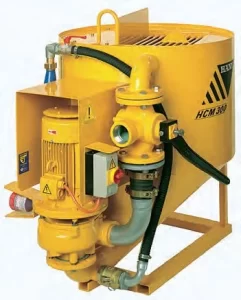Grout mixers play an essential role in the construction industry, ensuring a homogeneous mix of grout for various applications such as sealing, waterproofing, and filling gaps. Employed in large-scale infrastructure projects, down to residential building or renovation work, their importance can’t be overstated. Pneumatic grout mixers, in particular, bring efficiency, reliability, and precision to this task.
The mixers leverage the power of air pressure – the pneumatic system – which allows for smooth operations, easy maintenance, and superior control over the mixing process.
How a Pneumatic Grout Mixer Works
A pneumatic system uses compressed air to generate force and motion. But how? Let’s see. The mixer system is made up of several key parts: a compressor, a reservoir or tank, valves, and actuators.
The compressor is responsible for pressurizing the air, which is then stored in the tank. The pressurized air is regulated using multiple valves and is used to drive the actuators, converting the stored energy into mechanical energy that does the mixing.
Advantages of Pneumatic Grout Mixers
Efficiency and Speed
Pneumatic rout mixers, due to their inherent design and functioning, are exceptionally efficient. They operate at high speed, enabling machinery to accomplish tasks rapidly and increasing overall productivity.
Safety
Since grout mixers use air as their operating medium, there is no risk of leakage causing a fire, making them a safer choice for hazardous environments. They are also resistant to overheating, further enhancing their safety profile.
Reliability and Durability
Pneumatic systems are robust and can withstand harsh operating conditions. They are less susceptible to damage, ensuring reliable operation over extended periods.
Cost-Effective
These systems require minimal maintenance and are less expensive to install and operate compared to their hydraulic and electrical counterparts. This cost-effectiveness extends to their long-term use as well.
Simplicity of Design
Pneumatic grout mixers are typically simpler in design than other systems, making them easier to understand, operate, and maintain.
Versatility
The mixers can be used in a wide range of applications, from heavy machinery operation to delicate processes requiring precise control, due to their adjustable pressure and speed.
What is a grout pump used for?
A grout pump is a specialized piece of equipment used in construction and engineering projects to inject grout material into the ground or structures. Grout, a mixture often made up of water, cement, sand, and sometimes fine gravel, is designed to fill gaps or reinforce existing structures.
These pumps are essential for tasks such as soil stabilization, sealing joints in tunnels and sewers, repairing concrete cracks, and anchoring machinery or steel supports in place. The use of a grout pump allows for precise application and deep penetration of the grout into difficult-to-reach areas, ensuring the durability and integrity of the construction or repair work.
What is a colloidal grout mixer?
A colloidal grout mixer is an advanced device designed to efficiently mix cementitious and other types of grout to the required consistency for specific construction and engineering applications. Unlike traditional mixers, a colloidal mixer uses high-speed, high-shear mixing to break down particles, creating a highly stable and homogenous mixture.
This method significantly reduces the mixing time while ensuring that the grout is thoroughly blended, free of lumps and evenly distributed. The resulting mixture is ideal for a variety of grouting tasks, including soil stabilization, waterproofing, and underpinning, as it improves the flow and penetration of the grout into small voids and between tightly packed particles.
What do you mix with grout for pumping?
The composition of the mixture used for pumping through a grout pump depends on the specific requirements of the project. Typically, for most applications, water, cement, and sand serve as the base components. However, additives can be included to enhance the properties of the grout based on the intended use.
- Water: Acts as the primary mixing liquid that facilitates the flow of grout through the pump and into the required spaces.
- Cement: Provides the binding material that hardens over time, offering structural support.
- Sand: Used to give body to the grout, increasing its volume and strength. Fine sand is often preferred for its ability to permeate smaller voids.
Additives may include:
- Plasticizers: Improve the fluidity of the grout without increasing the water content, allowing for easier pumping and better penetration.
- Bentonite: A clay substance that can be added to increase the viscosity of the grout, making it more stable.
- Fibers: Enhance the structural integrity of the grout, reducing the propensity for cracks to develop as it sets.
- Anti-shrinkage compounds: Help to minimize the reduction in volume as the grout dries, ensuring it fills the intended space effectively.
How do you mix grout mix?
Mixing grout mix correctly is crucial for the successful application of grout in construction projects. To achieve the desired consistency and properties, follow these general steps:
- Prepare the Ingredients: Measure the water, cement, sand, and any additives based on the specific requirements of your project. It’s important to follow the manufacturer’s recommendations for ratios to ensure optimal performance.
- Mixing Process:
Start by adding a portion of the water to the mixing container.
Gradually incorporate the cement and sand, mixing continuously to prevent lumps from forming.
Add the rest of the water as needed and any specified additives. The order of adding additives can affect the mixture, so consult the product guidelines.
Use a mechanical mixer at a low to medium speed to achieve a homogenous mix. Avoid overmixing, as this can affect the setting time and strength of the grout.
What else can I use to mix grout?
For mixing grout effectively, a variety of tools and equipment can be used, depending on the scale of your project and the specific type of grout being mixed. For small-scale tasks and DIY projects, a simple mixing paddle attached to a standard drill offers sufficient mixing power to achieve a uniform consistency.
For larger projects requiring more volume of grout, a professional-grade mixing drill or a stationary mixer may be necessary to handle the increased workload and ensure even mixing throughout. It’s also possible to mix grout manually with a mortar hoe or a mixing stick, although this method is more labor-intensive and may not provide as consistent a mixture as mechanical methods.
Always ensure that the tools used for mixing are clean and free from residues of previous mixes to prevent contamination and ensure the quality of your grout mix.
What is the ratio of water to grout mix?
The ratio of water to grout mix is pivotal in determining the final quality and effectiveness of the grout. Typically, manufacturers provide specific recommendations for the best water-to-mix ratio on their packaging, which should be followed closely to achieve optimal results. In general, a ratio ranging from 4:1 to 6:1 (water-to-dry mix by volume) is commonly used for most standard grout types. However, the exact ratio can vary depending on the type of grout being used, its intended application, and environmental factors such as humidity and temperature at the time of application.
It’s crucial to measure the components accurately and to mix them thoroughly to ensure the grout achieves the right consistency and adheres properly to its application surface. A mixture that’s too thin will not provide the necessary strength, whereas a too thick mixture can be difficult to apply and might not fill gaps effectively. Always aim for a creamy and smooth consistency, similar to peanut butter, which indicates that the grout is ready for use.
What can I mix with grout to make it stronger?
To enhance the strength and durability of grout, various additives can be mixed with the grout. These additives are designed to increase the grout’s resistance to water, stains, and cracking, making it more suitable for areas with high moisture or heavy foot traffic. One common additive is latex, which can be added to the grout mix to improve its adhesive properties and flexibility, thus preventing cracks.
Another option is to use an epoxy grout that includes a hardener and resin, providing a waterproof and highly durable joint filler. For standard grout mixes, adding a grout fortifier instead of water can also improve the mix’s strength and longevity. Always follow the manufacturer’s instructions when using additives to ensure the best results and to maintain the warranty on the grout product.
What is the pressure on a grout pump?
The pressure on a grout pump is a critical factor in the application of grout, as it determines the efficiency and effectiveness with which the material is injected into the required spaces. This pressure must be carefully adjusted based on the type of grout being used, the distance it needs to be pumped, and the specifics of the job at hand. For example, higher viscosity grouts or longer pumping distances may require higher pressures.
Grout pump pressures can range from a few pounds per square inch (psi) for simple applications to over a thousand psi for more demanding tasks. It’s important to consult the pump manufacturer’s guidelines and the grout mixing instructions to determine the optimal pressure setting. Using too low a pressure may result in incomplete filling of gaps, while excessive pressure can cause damage to the surrounding structures or lead to inefficient use of grout materials.
What is the best concrete mix for pumping?
The best concrete mix for pumping is one that balances workability, strength, and durability while being fluid enough to pass through the pump and piping system without causing blockages or segregation. Key factors influencing this balance include the mix’s water-cement ratio, aggregate size, and the use of admixtures. For instance, for a class 30 or higher concrete, a water-cement ratio of 0.4 to 0.5 is considered ideal for pumpability.
A lower water-to-cement ratio is generally preferred to achieve higher strength and durability, but sufficient water is necessary to afford the mix adequate workability for pumping. That’s why superplasticizers are often added to reduce the water content without sacrificing fluidity. The aggregate size should be chosen based on the internal diameter of the pump and pipes, with a rule of thumb being that the maximum aggregate size should not exceed one-third of the pipe’s diameter.
Choosing the Right Pneumatic Grout Mixer

When it comes to selecting the right pneumatic grout mixer, several factors need to be considered.
1. Capacity
Capacity refers to the maximum amount of grout that a mixer can hold and mix at one time. This factor is crucial, as it will determine the efficiency of your project and how often you need to refill the mixer. If you have a large-scale project, opt for a pneumatic grout mixer with a higher capacity to reduce downtime and increase productivity.
2. Power
Power is another crucial factor to consider when choosing a pneumatic grout mixer. The power of the mixer will determine how quickly and efficiently it can mix the grout. Look for a model with high air pressure and horsepower ratings for optimal performance.
3. Portability
Portability is essential, especially if you have multiple job sites or need to move the mixer around during construction. Pneumatic grout mixers are generally more portable than electric or hydraulic ones, but still, consider the weight and size of the mixer before making a purchase.
4. Durability and Maintenance
As with any equipment, durability, and maintenance are crucial factors to consider when choosing a pneumatic grout mixer. Look for models made from high-quality materials that can withstand the rigors of construction work. Additionally, opt for mixers with fewer moving parts to reduce maintenance needs and increase their lifespan.
5. Cost
Last but not least, consider the cost of the mixer and your budget. While pneumatic grout mixers may have a higher initial setup cost, they generally require less maintenance and have a longer lifespan than other mixers, making them a cost-effective option in the long run. However, be sure to compare prices and features from different manufacturers to find the best value for your money.
Conclusion
A pneumatic grout mixer is a vital piece of equipment in construction and renovation projects, particularly when working with tiles. It simplifies the process of mixing grout, making it quicker, more efficient, and less labor-intensive. These mixers leverage air pressure to facilitate the mixing process, resulting in a smooth, well-blended grout that enhances the quality and longevity of the tile work.
The advantages of pneumatic grout mixers are manifold. They are user-friendly, require minimal maintenance, and generally have a longer lifespan compared to other mixers. This makes them a cost-effective choice despite their higher initial setup cost.
Looking at future trends, we can anticipate that grout mixer technology will continue to evolve. Developments could include more energy-efficient models, mixers with refined control mechanisms for better precision, and the integration of smart technology for monitoring performance metrics. Such advancements will contribute to maximizing productivity, enhancing safety standards, and ensuring a sustainable, environmentally friendly operation.

